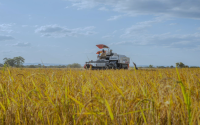New Bread Baskets Emerging in the Western Regions of Tanzania
Kigoma
*Partnerships for agricultural transformation results in the regions of Kigoma, Kagera, and Katavi leapfrogging to become significant producers of food for Tanzania and the neighboring countries to the west of Tanzania
The work supported by PiATA-TIJA initiative has contributed to enabling the regions of Kagera, Kigoma, and Katavi to emerge as new food basket zones. The work also enhanced further the role that Rukwa Region plays as one of the “big four” in food production in Tanzania.
During the last three years, with support of the partnership and others, those three western regions have made strides in becoming dependable net food exporters and are enhancing Tanzania’s status as the food powerhouse in East African Community (EAC) and the Southern African Development Community (SADC), according to Mr. Vianey Rweyendela, AGRA County Manager for Tanzania.
The Bank of Tanzania (BoT) 2018/19 annual report puts agriculture, construction, and transport as the fastest growing economic activity, while the 2017/18 puts construction, transport and storage, agriculture, and information and communication activities as the drivers of growth. This underpins the increasing cardinal role agriculture is playing in the development of Tanzania.
It is estimated that production yield (metric ton/hectare) of two key staples-maize and beans increased by 230 % and 100 % respectively in the 4 regions under review, while rice production yield increased by 67 % in Katavi and Rukwa regions, which has led to surplus production and pathway to increased incomes for smallholder farmers.
This progress is helping Tanzania to strengthen its position as one of the most food-secure countries in Africa, having maintained national food self-sufficiency for over a decade and subsequently putting in place a good foundation for the agriculture-based industrialized and middle-income economy.
According to the Tanzania Minister of Agriculture, Hon Japhet Hasunga (MP), food production has continued to improve in the country. In his 2020/21 budget speech, he reported that in the 2019/20 cropping season, Tanzania will achieve 121% food self-sufficiency, translating to a surplus of 2.8 Million Metric Tons (MT).
The PiATA-TIJA initiative in Tanzania is part of a pan-African Partnership for Inclusive Agricultural Transformation in Africa (PIATA), implemented by the Alliance for a Green Revolution in Africa (AGRA).
The resource partners of PIATA are Bill & Melinda Gates Foundation (BMGF); Rockefeller Foundation (RF); United States Agency for International Development (USAID), Department for International Development (DFID), and German Federal Ministry for Economic Cooperation and Development (BMZ). AGRA invests resources to catalyze partnerships that bring together the central government, local governments, private sector in the inputs and output markets, and smallholder farmers; to enable the development of strong food value chains.
PiATA-TIJA reaches out to 550,000 smallholder farmers in the four regions
About 550,000 smallholder farmers in the four regions have been impacted by PiATA-TIJA, leading to a marked growth of the private sector along value chains of maize, beans, rice, and cassava. This is thanks to the increased availability of inputs near smallholder farmers due to an increased number of agro-dealers which has translated into increased usage of improved technology and highly enhanced productivity.
The farmers were impacted in diverse extension services and capacitated to increase income and improve food security thanks to increased productivity, access to market, and finance.
“We are working very closely with the government to make Tanzania become more competitive and foster inclusive economic growth. We are supporting the government to enhance agricultural sector coordination and evidence-based planning,” noted Mr. Rweyendela.
PiATA-TIJA milestones pathway to increased incomes for smallholder farmers
He noted some of the major milestones achieved by the farmers supported by PiATA-TIJA in the three consortia:
- 230 % increased maize yield productivity (from an average of 1.125 in 2017 to 3.75 metric ton/hectare, 2019)
- 100 % increased bean yield productivity (from an average of 0.675 in 2017 to 1.35 metric ton/hectare, 2019)
- 67 % increased rice yield productivity (from an average of 3 in 2017 to 5 metric ton/hectare, 2019)
- 220% increase in Agro inputs shops (from 395 in 2017 to 1269 in 2019).
- 400 % increased fertilizer sales ( 4428 MT in 2017 to 22,401 MT in 2019.)
- 238% increased purchase of improved maize seeds sales (from 434 MT in 2017 to 14,54 MT in 2019.
- 45 % increased the number of processors in Rukwa/Katavi (from 28 in 2017 to 63 in 2019.
- 127% increased annual processing capacity for SME processors in Kagera from 7165MT in 2017 to 16265MT in 2019.
- Supported construction of about 10 new warehouses and modernization of over 40 warehouses belonging to the private sector, farmers’ groups, and in some cases the public sector.
- Supported 5000 agro-dealers with capacity building making it possible for more smallholder farmers to access inputs- seeds, fertilizers, post-harvest technology, etc
PiATA-TIJA key results in empowering smallholder farmers
Emerging data indicate that Kigoma and Kagera’s maize productivity yield (4 metric ton/hectare, 2019) overtook traditional powerhouse Katavi/Rukwa(3.5 metric ton/hectare, 2019), which implies that areas impacted by Piata Tija show improved productivity, which if replicated in the four regions leading to new improved dynamics in production.
To generate increased outcomes, PiATA-TIJA delivered a number of key results, including but not limited to the following:
- Contributed to improving the environment for agriculture value chain broad-based growth in the four regions
- Contributed in reclaiming/expanding domestic market for key staple food and subsequently increased investment for traders along the value chain
- Contributed to increasing the capacity of traders to leverage the export market opportunities through links between producers, off-takers, and end markets with neighboring countries.
- Contributed in developing productivity systems including seed production, fertilizer supply chains, agro-dealership, and extension.
- Contributed In creating an environment for processors to scale up capacity and improve quality
- Contributed to creating an environment for greatly reduced post-harvest losses for grains, thanks to an increased number and capacity of warehouses.
- Contributed to creating an environment for greater mechanization
- Contributed to the increased availability of inputs in the villages
PiATA-TIJA’s “markets first” approach
To enhance economic benefits for the farmers a “markets first” approach was used in the development of the value chains, by focusing on value-added processing and trading.
The net effect has been an increase in food security, trade, processing, and cross border trade as the centerpiece of the roadmap to an economic leapfrog.
“There is an increase in food security as well as increased trade, processing, and cross border trade as the centerpiece of the roadmap to an economic leapfrog. Produce in Kigoma Consortium has a huge export market in Burundi, Rwanda and DRC Congo, while Kagera Consortium has an export market base in Uganda, Rwanda, Burundi, DRC Congo, and South Sudan. For the SUKA Consortium, it has an export market in Zambia, Rwanda, and DRC Congo,” noted Mr. Rweyendela.
The actual data produced exported in the region is under the collection. At the national level, the regions contributed selling grains to the National Food Reserve Agency(NFRA) Bank of Tanzania shows that NFRA in 2018/19 had food stock (grains, mainly maize) between 62,288.0 tonnes and 95,534.1 tonnes. “The stock of food held by the NFRA at the end of June 2019 was 67,335.9 tonnes, higher than 63,843.9 tonnes at the end of June 2018,” noted the bank’s annual report. 2018/19 NFRA purchased 47,115 tonnes of maize from farmers and sold out about 42,068 tonnes. From 201/18-2018/19 major exports to the EAC region were beans, maize grain, sisal rope, and tea.
PiATA-TIJA’s multiplier effect includes an increased level of private sector investments
The consortium model, notes Mr. Rweyendela, has brought increased levels of investments in input supplies- from mechanization, seeds, fertilizers, and post-harvest technology and on the other hand higher-level processing and marketing beyond Tanzania’s borders. There is a marked increase in inputs (improved seeds and fertilizers) manifested by increased production and a private sector with greater capacity, Mr. Rweyendela, noted.
The four regions collectively have higher productivity levels due to higher use of technology, adoption of the use of improved seeds and fertilizers, and are on the right track to compete with traditional food basket areas in Tanzania.
We have strengthened agricultural inputs systems (agro-dealers’ networks) to build linkages between input companies, hub agro, dealers, retail agro-dealers, and farmers while taking into consideration warehousing and access to markets, noted Mr. Rweyendela.
A smallholder farmer, Mrs. Edina Josephat, from Rwabigaga Village in Kagera, who plants maize, beans, and cassava in her 2-acre piece of land said that the most important thing PiATA-TIJA initiative has contributed to her life was knowledge about markets and access to markets.
“The beauty of farming is when it pays, when you know after harvest, sometimes later, you will be able to sell your products and earn a good living. For me, markets are everything and that is what I value most about PiATA-TIJA,”
One of the private sector partners in Kigoma Consortium, Mr. Charles Makule, the Managing Director, Kitutu Enterprises & General Supplies, thanked AGRA for helping him to increase storage capacity from 50MT to 300MT, an increase of 500 percent.
“I thank AGRA for the PiATA-TIJA initiative. It has personally helped me to increase the processing of fortified maize flour from 1MT per day to 2MT per day. This means we are able to buy more maize from smallholder farmers,” he said.
Mr. Boniventure Venance, Planning Officer, Tanzania Chamber of Commerce Industry and Agriculture (TCCIA), the implementation of PiATA Tija initiative has played a big role in addressing the missing links that were needed to improve farming for increased productivity in Western Tanzania.
“PiATA Tija has played a key role in empowering communities and SME’s (mostly small scale farmers) with skills to start and run profitable businesses, while also improving the business environment, he said.
“Smallholder farmers are proud to have increased income. They have also participated in improving the business environment, sharing their needs and aspirations with policymakers including drafting of crop bylaws, noted Mr. Boniventure.
A hub Agro-dealer, Mama Bwilo, based in Sumbawanga, and connected to 30 Village-Based Advisors (VBAs), noted: “Thanks to PiATA Tija my input sales volume as well as my distribution channels have expanded. The initiative has helped to serve an additional 13 retail agro-dealers,” she said. In 2018/19 she served over 10,000 smallholder farmers and sold about 437MT seeds and 200MT fertilizer.
AGRA supporting Tanzania in two groundbreaking programs
In supporting the government of Tanzania to beef up agriculture, from 2006 to 2020 AGRA has invested/committed a total of USD 75 M. In 2019/ 20, period AGRA is supporting Tanzania in two groundbreaking programs that will enable the scaling-out of the achievements in the four regions to the rest of the country. The first is the support given to the government, through the ASDP-II coordinating mechanism to develop an Agro-industrialization Development and Investment Flagship (TAIDF), a major component of the Industrialization Drive by the 5th Phase Government. The second is support through TAMISEMI to enable the government to Strengthen the Coordination of ASDP-II by Local Government Authorities (SCALGA).
AGRA is an African-led, Africa-based institution transforming smallholder agriculture from a solitary struggle to survive into farming as a business that thrives. Its goal is to increase incomes and improve food security for 30 million farming households in 11 African countries by 2021.
————————————————————————————————


